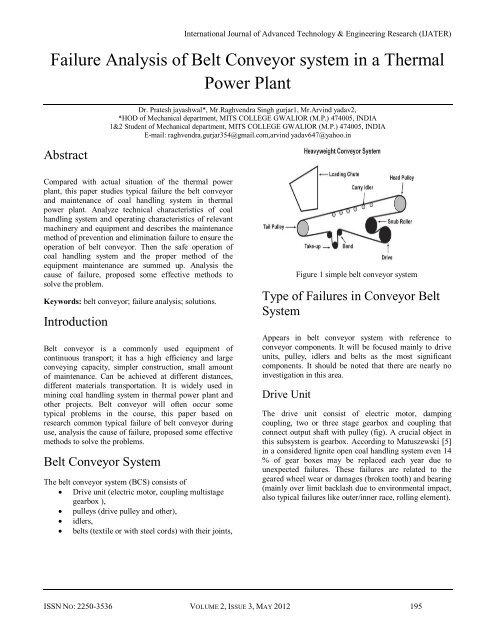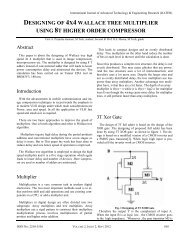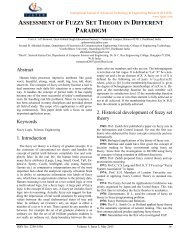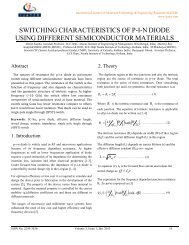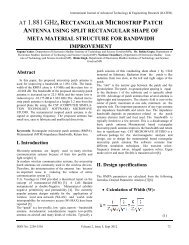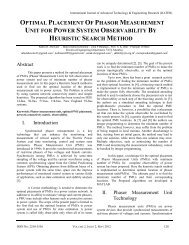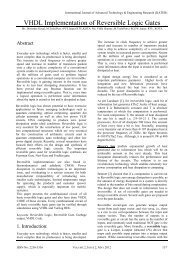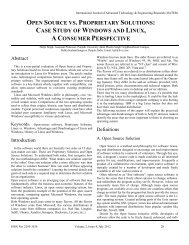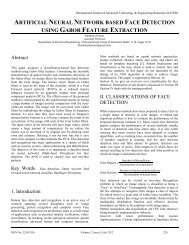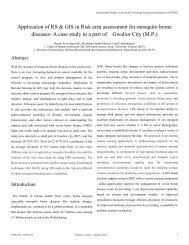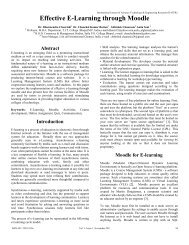Failure Analysis of Belt Conveyor system in a Thermal Power ... - ijater
Failure Analysis of Belt Conveyor system in a Thermal Power ... - ijater
Failure Analysis of Belt Conveyor system in a Thermal Power ... - ijater
- No tags were found...
Create successful ePaper yourself
Turn your PDF publications into a flip-book with our unique Google optimized e-Paper software.
International Journal <strong>of</strong> Advanced Technology & Eng<strong>in</strong>eer<strong>in</strong>g Research (IJATER)<strong>Failure</strong> <strong>Analysis</strong> <strong>of</strong> <strong>Belt</strong> <strong>Conveyor</strong> <strong>system</strong> <strong>in</strong> a <strong>Thermal</strong><strong>Power</strong> PlantAbstractDr. Pratesh jayashwal*, Mr.Raghvendra S<strong>in</strong>gh gurjar1, Mr.Arv<strong>in</strong>d yadav2,*HOD <strong>of</strong> Mechanical department, MITS COLLEGE GWALIOR (M.P.) 474005, INDIA1&2 Student <strong>of</strong> Mechanical department, MITS COLLEGE GWALIOR (M.P.) 474005, INDIAE-mail: raghvendra.gurjar354@gmail.com,arv<strong>in</strong>d yadav647@yahoo.<strong>in</strong>Compared with actual situation <strong>of</strong> the thermal powerplant, this paper studies typical failure the belt conveyorand ma<strong>in</strong>tenance <strong>of</strong> coal handl<strong>in</strong>g <strong>system</strong> <strong>in</strong> thermalpower plant. Analyze technical characteristics <strong>of</strong> coalhandl<strong>in</strong>g <strong>system</strong> and operat<strong>in</strong>g characteristics <strong>of</strong> relevantmach<strong>in</strong>ery and equipment and describes the ma<strong>in</strong>tenancemethod <strong>of</strong> prevention and elim<strong>in</strong>ation failure to ensure theoperation <strong>of</strong> belt conveyor. Then the safe operation <strong>of</strong>coal handl<strong>in</strong>g <strong>system</strong> and the proper method <strong>of</strong> theequipment ma<strong>in</strong>tenance are summed up. <strong>Analysis</strong> thecause <strong>of</strong> failure, proposed some effective methods tosolve the problem.Keywords: belt conveyor; failure analysis; solutions.Introduction<strong>Belt</strong> conveyor is a commonly used equipment <strong>of</strong>cont<strong>in</strong>uous transport; it has a high efficiency and largeconvey<strong>in</strong>g capacity, simpler construction, small amount<strong>of</strong> ma<strong>in</strong>tenance. Can be achieved at different distances,different materials transportation. It is widely used <strong>in</strong>m<strong>in</strong><strong>in</strong>g coal handl<strong>in</strong>g <strong>system</strong> <strong>in</strong> thermal power plant andother projects. <strong>Belt</strong> conveyor will <strong>of</strong>ten occur sometypical problems <strong>in</strong> the course, this paper based onresearch common typical failure <strong>of</strong> belt conveyor dur<strong>in</strong>guse, analysis the cause <strong>of</strong> failure, proposed some effectivemethods to solve the problems.<strong>Belt</strong> <strong>Conveyor</strong> SystemThe belt conveyor <strong>system</strong> (BCS) consists <strong>of</strong> Drive unit (electric motor, coupl<strong>in</strong>g multistagegearbox ), pulleys (drive pulley and other), idlers, belts (textile or with steel cords) with their jo<strong>in</strong>ts,Figure 1 simple belt conveyor <strong>system</strong>Type <strong>of</strong> <strong>Failure</strong>s <strong>in</strong> <strong>Conveyor</strong> <strong>Belt</strong>SystemAppears <strong>in</strong> belt conveyor <strong>system</strong> with reference toconveyor components. It will be focused ma<strong>in</strong>ly to driveunits, pulley, idlers and belts as the most significantcomponents. It should be noted that there are nearly no<strong>in</strong>vestigation <strong>in</strong> this area.Drive UnitThe drive unit consist <strong>of</strong> electric motor, damp<strong>in</strong>gcoupl<strong>in</strong>g, two or three stage gearbox and coupl<strong>in</strong>g thatconnect output shaft with pulley (fig). A crucial object <strong>in</strong>this sub<strong>system</strong> is gearbox. Accord<strong>in</strong>g to Matuszewski [5]<strong>in</strong> a considered lignite open coal handl<strong>in</strong>g <strong>system</strong> even 14% <strong>of</strong> gear boxes may be replaced each year due tounexpected failures. These failures are related to thegeared wheel wear or damages (broken tooth) and bear<strong>in</strong>g(ma<strong>in</strong>ly over limit backlash due to environmental impact,also typical failures like outer/<strong>in</strong>ner race, roll<strong>in</strong>g element).ISSN NO: 2250-3536 VOLUME 2, ISSUE 3, MAY 2012 195
199319941995199619971998199920002001200220032004International Journal <strong>of</strong> Advanced Technology & Eng<strong>in</strong>eer<strong>in</strong>g Research (IJATER)Figure 2 scheme <strong>of</strong> drive unit <strong>in</strong> belt conveyor <strong>system</strong>It is easy to notice the significant decreas<strong>in</strong>g number <strong>of</strong>failure for 2004-2006 one <strong>of</strong> possible reason is that coalhandl<strong>in</strong>g <strong>system</strong> us<strong>in</strong>g condition monitor<strong>in</strong>g techniques.In this section will be consider the types <strong>of</strong> fault that35Figure 4 Percentage <strong>of</strong> failure for gearboxes used <strong>in</strong> coalhandl<strong>in</strong>g <strong>system</strong>30252015105totalnumber<strong>of</strong>failuregearedwheelbear<strong>in</strong>g0Figure 3 Number <strong>of</strong> failure <strong>of</strong> drive unit gearbox used <strong>in</strong>belt conveyor <strong>system</strong><strong>Analysis</strong> for drive units used <strong>in</strong> coal handl<strong>in</strong>g <strong>system</strong>done by [6]show that over 50% problems are related to<strong>in</strong>put stage that is a bevel stage.PulleysFigure 5 Example <strong>of</strong> damaged geared wheelThe pulley consists <strong>of</strong> two bear<strong>in</strong>g, shaft, shell andcoat<strong>in</strong>g (special material <strong>in</strong> order to improve belt-pulleycontact), figFigure 6- pulleyISSN NO: 2250-3536 VOLUME 2, ISSUE 3, MAY 2012 196
199319941995199619971998199920002001200220032004Ma<strong>in</strong>DepartmentAs it is shown on fig. (The number <strong>of</strong> failures depend<strong>in</strong>gon pulley type) especially drives are very sensitiveelements.International Journal <strong>of</strong> Advanced Technology & Eng<strong>in</strong>eer<strong>in</strong>g Research (IJATER)Figure 7 Number <strong>of</strong> failure for different types <strong>of</strong> pulleysused <strong>in</strong> coal handl<strong>in</strong>g mach<strong>in</strong>esAs Matuszewski [5] shown number <strong>of</strong> pulley failures mayreach over 60 per year that is 12% <strong>of</strong> used pulleys, fig.one may notice two sources <strong>of</strong> primary problems, namely:bear<strong>in</strong>g, shell and coat<strong>in</strong>g.70605040302010035302520151050KWK1500sKWK800MRs 560SchRs900dropp<strong>in</strong>gotherdrivetotalnumber<strong>of</strong>failurebear<strong>in</strong>gFig. 9 Examples <strong>of</strong> pulley faultsMotor-Coupl<strong>in</strong>g-Gearbox-Pulley <strong>in</strong> CoalHandl<strong>in</strong>g SystemBased on data obta<strong>in</strong>ed from ma<strong>in</strong>tenance department(data from period January- November 2008) <strong>in</strong> one coalhandl<strong>in</strong>g <strong>system</strong> a simple analysis have been performed <strong>in</strong>order to get the conv<strong>in</strong>ce that many breakdown situationscould be omitted if CM is used. In fig. we show that forso called department /flat BCS (MBCS) number <strong>of</strong>breakdowns is much higher than that for smaller, so calleddepartment/flat BCS (DBCS). The reason <strong>of</strong> this is thatMBCS is heavier loaded than DBCS (SEE FIG.)6050403020100Number <strong>of</strong> failure vs type <strong>of</strong>belt conveyorNumber <strong>of</strong>failure vs type<strong>of</strong> beltconveyorIn fig.8 one may see examples <strong>of</strong> damaged pulley coat<strong>in</strong>gand bear<strong>in</strong>gFigure-10 Number <strong>of</strong> failure related to MBCS and DBCSIn fig.9 the number <strong>of</strong> failure related to elements <strong>of</strong> driveunit is presented. As one may see the number <strong>of</strong> failure ismore or less similar for each element, however thenumber <strong>of</strong> failures <strong>of</strong> gearboxes is <strong>in</strong> the highest value.ISSN NO: 2250-3536 VOLUME 2, ISSUE 3, MAY 2012 197
International Journal <strong>of</strong> Advanced Technology & Eng<strong>in</strong>eer<strong>in</strong>g Research (IJATER)3020100number <strong>of</strong> failure <strong>of</strong> driveunitcoupl<strong>in</strong>ggearbox motorpulleynumber<strong>of</strong>failure<strong>of</strong> driveunitbelt (tear, puncture, cut <strong>of</strong> belt and abrasion <strong>of</strong> bottom/topcovers) and its jo<strong>in</strong>ts (connected us<strong>in</strong>g glue, vulcanized ormechanical jo<strong>in</strong>t) [10, 11]. Because <strong>of</strong> dimension andweight <strong>of</strong> a belt it needs to be transported <strong>in</strong> rolls, piecesup to 100-400 m long, depends on a belt type. In order toreplace damaged a gearbox or pulley heavy mach<strong>in</strong>ery isrequired. In some cases due to environment impact (forexample ra<strong>in</strong>) it takes a few times longer time.Typical faults <strong>of</strong> belt<strong>Conveyor</strong> belt deviationFigure 11 Number <strong>of</strong> failure related to elements <strong>of</strong> drive unit(motor-coupl<strong>in</strong>g-gearbox-pulley)IDLERSThe failure analysis <strong>of</strong> idlers and belts are a bit differentissue [7, 8, and 11]. Idler are used for support<strong>in</strong>g belt withtransport materials. In some sense idlers are similar topulleys and consist <strong>of</strong> bear<strong>in</strong>g and shell. One may expectsimilar types <strong>of</strong> failures. The support <strong>system</strong> for beltconsists <strong>of</strong> three idlers. Because <strong>of</strong> different load <strong>of</strong> eachidler usually side idlers are more subjected to damage.Worn Bear<strong>in</strong>g <strong>in</strong> idlers will significantly <strong>in</strong>crease externalload for drive units so power consumption will <strong>in</strong>crease.Damaged idlers and pulleys may be reason <strong>of</strong> damage forbelts.Figure 12 - Distribution <strong>of</strong> load along belt - idler contact areaIf one consider the impact <strong>of</strong> damaged idlers it is anotherstory. The idlers are quite small <strong>in</strong> comparison to pulley;however, number <strong>of</strong> idlers is huge. Damaged idlers maycause failure <strong>of</strong> belt (the cut <strong>of</strong> a belt ) or even may startfire (belt slipp<strong>in</strong>g on damaged idler may <strong>in</strong>creasetemperature up to 400 o C, 450 o C is the limit for so called“difficult-to-burn” belt ) and as it was mentioned energyconsumption is a ris<strong>in</strong>g dramatically.<strong>Belt</strong>Depends on application, belt used <strong>in</strong> conveyor <strong>system</strong>may be divided <strong>in</strong>to two groups: textile belts and steelcords belts. In coal handl<strong>in</strong>g thermal plant usually textilebelts are used. Expected problems for belts are related toIn the belt conveyor, as the conveyor belt is tractioncomponents, transmit power and motion, and also iscarry<strong>in</strong>g components, support material load. Work<strong>in</strong>gmore complex, so at work <strong>of</strong>ten happen belt deviation.Deviation is the conveyor belt dur<strong>in</strong>g operation, the centerl<strong>in</strong>e <strong>of</strong> belt deviation the center l<strong>in</strong>e <strong>of</strong> conveyor. as theconveyor belt deviation may cause between the belt edgeand rack wear, cause belt edge premature damage,rang<strong>in</strong>g impact the life <strong>of</strong> conveyor, affect the throughput<strong>of</strong> material, weight is caused by withdrawal material, evenhappen stop occurrence, direct impact on production. Asthe conveyor belt is more important, the most expensiveparts. Its price about 25%-50% to the conveyor. Soanalysis the reason <strong>of</strong> belt deviation, reduce and elim<strong>in</strong>atebelt deviation, it is an important part <strong>of</strong> ensure belt towork, extent equipment life. Cause the belt occursdeviation because <strong>of</strong> the follow<strong>in</strong>g factors.In the device itselfa. Rack rigid is poor, large deformation under load,caus<strong>in</strong>g the belt deviation.b. The larger error <strong>of</strong> roller outer cyl<strong>in</strong>drical,caused deviation when the conveyor belt runn<strong>in</strong>gc. The support<strong>in</strong>g roller rotation is not flexible,because the conveyor belt both sides stress to beuneven, because the conveyor belt deviation.d. The parallelism error cyl<strong>in</strong>drical axis and rolleraxis is too big \, causes the conveyor beltdeviation.e. <strong>Conveyor</strong> belt itself is questionable quality, th<strong>in</strong>and thick uneven, caused a shock lead runn<strong>in</strong>gconveyor belt deviation.f. Not parallel with belt connector, connection erroris too big, cause belt deviation.Installation adjustmenta. Drive change roller axis and conveyor centerl<strong>in</strong>evertical error is too big; make conveyor andhorizontal l<strong>in</strong>e have a bigger <strong>in</strong>cl<strong>in</strong>ation, causebelt deviation.b. Roller axis and conveyor centerl<strong>in</strong>e vertical erroris big will cause belt deviation also.ISSN NO: 2250-3536 VOLUME 2, ISSUE 3, MAY 2012 198
International Journal <strong>of</strong> Advanced Technology & Eng<strong>in</strong>eer<strong>in</strong>g Research (IJATER)c. The connection strength between rack andground is not enough, the rack unstable, caus<strong>in</strong>gbelt deviation.d. The feed<strong>in</strong>g plate <strong>of</strong> discharge through andimproperly located, both sides <strong>of</strong> the conveyorbelt uneven force cause belt deviation.With ma<strong>in</strong>tenancea. The clean<strong>in</strong>g performance <strong>of</strong> sweeper is poor;make the roller cyl<strong>in</strong>drical diameter local<strong>in</strong>creases.b. Feed<strong>in</strong>g mouth location is wrong, so that thematerial partial load on the conveyor belt, causebelt deviation.c. Poor ma<strong>in</strong>tenance and improper adjustment,result<strong>in</strong>g <strong>in</strong> the conveyor belt deviation.d. For the steel cord belt, as the manufacture <strong>of</strong>steel cord is uneven force, so that a deviationoccurs <strong>in</strong> the operation, or a strong difference <strong>of</strong>belt, large elongation under load, caus<strong>in</strong>g thevibration, the belt will deviation.e. Also, the vibration <strong>of</strong> runn<strong>in</strong>g conveyor belt<strong>system</strong> can cause the deviation.f. In addition, when convey<strong>in</strong>g some viscousmaterial, make the roller, etc. bond<strong>in</strong>g material;make the cyl<strong>in</strong>drical diameter <strong>of</strong> roller part<strong>in</strong>creases, caus<strong>in</strong>g conveyor belt deviation.Measures to prevent the beltdeviation1. Due to equipment <strong>in</strong> the manufacture <strong>of</strong>conveyor belt causes the deviation, primarilythrough improved design, manufacture precisionto prevent and reduce the occurrence <strong>of</strong> conveyorbelt deviation.2. For <strong>in</strong>stallation adjust improper and daily usecauses deviation, ma<strong>in</strong>ly the follow<strong>in</strong>g aspectsshould be considered:<strong>Conveyor</strong> belt <strong>in</strong> drive roller or on rear rollersdeviation, usually by adjust<strong>in</strong>g the position <strong>of</strong> rollerbear<strong>in</strong>g ways to elim<strong>in</strong>ate,a. The longitud<strong>in</strong>al centerl<strong>in</strong>e <strong>of</strong> the roller rotationaxis and conveyor is not perpendicular, result<strong>in</strong>g<strong>in</strong> the conveyor belt one side loose and othertight, belt move from the tight side to the looseside, occurs deviation phenomenon. Should beadjusted bear<strong>in</strong>g position <strong>of</strong> tighten deviationside. Make horizontal pull <strong>of</strong> belt equal,elim<strong>in</strong>ate deviation. When tail roller device bothsides screw rod are not equal, result<strong>in</strong>g <strong>in</strong> causedby imbalance.b. Cyl<strong>in</strong>drical axis is not horizontal, at both endsbear<strong>in</strong>g <strong>of</strong> height difference is cause anotherreason <strong>of</strong> head or tail deviation. At this po<strong>in</strong>t, atboth ends roller bear<strong>in</strong>g should add subtractshims way to level<strong>in</strong>g roller axis, to elim<strong>in</strong>ateconveyor belt deviation.c. Roller surface adhesion material, equivalent to<strong>in</strong>creas<strong>in</strong>g the roller local diameter, will causethe conveyor belt deviation, should strengthenempty segment clean<strong>in</strong>g <strong>of</strong> conveyor belt toreduce the adhesive material or dustaccumulation on the conveyor belt. In addition,the conveyor belt between the nose and tail partsdeviation, called central or local deviation. Suchdeviation reasons are more complex, it is withthe conveyor belt along device exposure to arelationship. Need a detailed analysis for specificissues. Us<strong>in</strong>g the follow<strong>in</strong>g method can resolvethese issues.A. Load or no- load branch roller axis with theconveyor belt runn<strong>in</strong>g centerl<strong>in</strong>e is notperpendicular, caus<strong>in</strong>g tape at the rollerdeviation. Deviation ends should adjustmentto the conveyor belt runn<strong>in</strong>g direction. Atthis <strong>of</strong>ten need to adjust the adjacent groups<strong>of</strong> order to achieve the purpose <strong>of</strong>elim<strong>in</strong>at<strong>in</strong>g deviation; adjust<strong>in</strong>g deviationangle should not be too big.B. <strong>Conveyor</strong> belt jo<strong>in</strong>t with the tape centerl<strong>in</strong>e(trumpet) is not perpendicular, to cause thedeviation, should improved <strong>in</strong>stallationconnection accuracy to elim<strong>in</strong>ate deviation.C. If material loaded on the conveyer belt isstraight; make the material block and weightdistribution along bandwidth directiondistribution serious <strong>in</strong>equality, causedeviation, through adjustment blank<strong>in</strong>g tubeand skirt plate location method to beelim<strong>in</strong>ated.Recently, it was suggested that the method <strong>of</strong>application film for transfer partial conveyor beltbecause <strong>of</strong> high manufactur<strong>in</strong>g costs and sometechnical problems not well solved, makes thismethod very difficult to promote the use.Solutionsa. In the roller manufactur<strong>in</strong>g process guarantee theaccuracy requirements, for example, press<strong>in</strong>g bear<strong>in</strong>gbore to achieve three precision, tubes at both ends <strong>of</strong>dimensional tolerances, concentricity and ovality mustmeet national standards. The products have strictquality <strong>in</strong>spection to ensure that all products qualified.Sealed lubrication, <strong>in</strong> addition to manufactur<strong>in</strong>g qualityassurance, go with good lubricat<strong>in</strong>g materials. Such asuse <strong>of</strong> lithium-based grease, can improve thelubrication <strong>of</strong> bear<strong>in</strong>g which extend the life <strong>of</strong> theroller is necessary.ISSN NO: 2250-3536 VOLUME 2, ISSUE 3, MAY 2012 199
International Journal <strong>of</strong> Advanced Technology & Eng<strong>in</strong>eer<strong>in</strong>g Research (IJATER)b. Bear<strong>in</strong>g used to ball bear<strong>in</strong>g support, plasticseal<strong>in</strong>g r<strong>in</strong>g labyr<strong>in</strong>th seal structure, this canensure roller worked reasonable force, whileensur<strong>in</strong>g dust effect good, resistance small, easyassembly and disassembly, easy to ma<strong>in</strong>ta<strong>in</strong>,reduce conveyor operat<strong>in</strong>g costs.c. For gearboxes (geared wheel and bear<strong>in</strong>g) andpulleys (bear<strong>in</strong>gs) may use a vibration measurebased techniques [2] and temperaturemeasurement for bear<strong>in</strong>g.d. For idler condition thermography measurementor noise may be used [13].e. For belt with steel cords nondestructivetechniques may be applied(measurement <strong>of</strong>magnetic field <strong>of</strong> steel cords)[14].for belt jo<strong>in</strong>tfor condition measurement some magnetic fieldsource may be placed <strong>in</strong> a jo<strong>in</strong>t area and by themeasurement <strong>of</strong> magnetic field the distancebetween these po<strong>in</strong>ts may be easily calculated[15]. In order to detect cut <strong>of</strong> cover it wasproposed by one <strong>of</strong> belt produce to place k<strong>in</strong>d <strong>of</strong>electromagnetic field transmitter. If belt is cut,electric circuit will be damaged and transmitterwill stop work<strong>in</strong>g [16, 17].ConclusionWide ranges applications <strong>of</strong> belt conveyors, and the workenvironment is generally more difficult, to keepequipment runn<strong>in</strong>g <strong>in</strong> good work<strong>in</strong>g condition, extendequipment life, improve the quality <strong>of</strong> operation, reduceoperat<strong>in</strong>g costs has been the goal <strong>of</strong> eng<strong>in</strong>eer<strong>in</strong>g andtechnical personnel. Analyze and resolve the impactnormal operation <strong>of</strong> the ma<strong>in</strong> problems, to ensure thegood function<strong>in</strong>g <strong>of</strong> device, it is an important work <strong>of</strong>equipment ma<strong>in</strong>tenance. This paper analyzes the proposedmethod. Helpful improve site ma<strong>in</strong>tenance staff levels tosolve practical problems, for practical project hasimportant significance.REFERENCES[1] <strong>Belt</strong> conveyor for bulk materials, fifth edition. Theconveyor Equipment Manufacturers Association, CEMAPress, USA, 1997.[2] BARTELMUS W., Condition Monitor<strong>in</strong>g.OpencastM<strong>in</strong><strong>in</strong>g Mach<strong>in</strong>ery, Published by Śląsk,Katowice, 1998.[3] Internal Materials from KWB Bełchatów M<strong>in</strong>e.[4] KOSTANSKI D., <strong>Failure</strong> analysis <strong>of</strong> belt <strong>Conveyor</strong><strong>system</strong>s <strong>in</strong> KWB Kon<strong>in</strong> m<strong>in</strong>e, Diploma Thesis, M<strong>in</strong><strong>in</strong>gFaculty (Supervisor Dr. R. Zimroz), Wroclaw 2008.[5] MATUSZEWSKI P., Condition Monitor<strong>in</strong>g <strong>in</strong>BOT KWB Belchatow m<strong>in</strong>e. Diploma thesis M<strong>in</strong><strong>in</strong>g,Faculty (supervisor pr<strong>of</strong>. W. Bartelmus), Wroclaw 2007.[6] SKOC A., Dynamics <strong>of</strong> bevel gears <strong>in</strong> m<strong>in</strong><strong>in</strong>gMach<strong>in</strong>es, M<strong>in</strong><strong>in</strong>g, No. 226, Silesian University OfTechnology, Gliwice 1996.[7] GLADYSIEWICZ L, KROL R.,ConditionMonitor<strong>in</strong>g <strong>of</strong> idlers. 1st Conference on Mechanization <strong>of</strong>M<strong>in</strong><strong>in</strong>g Industry, Institute <strong>of</strong> M<strong>in</strong><strong>in</strong>g MechanizationsSilesian University <strong>of</strong> Technology, 2002.[8] KROL R., JURDZIAK L., GŁADYSIEWICZ L.,Economy <strong>of</strong> <strong>Belt</strong> <strong>Conveyor</strong> Idlers Renovation Based OnResults <strong>of</strong> Laboratory Tests. Industrial Transport, nr2(2)/2008, Wroclaw 2008.[9] GŁADYSIEWICZ L., <strong>Belt</strong>s <strong>Conveyor</strong> – theoryAnd calculation, WUT Press, Wroclaw 2003.270 R.ZIMROZ, R. KRÓL[10] HARDYGÓRA M., WACHOWICZ J.,CZAPLICKA-KOLARZ K., MARKUSIK S.,<strong>Conveyor</strong> <strong>Belt</strong>s, publ. by WNT Warszawa 1999, ISBN83-204-2402-X.[11] JURDZIAK L:, <strong>Failure</strong> analysis <strong>of</strong> textile andSteel cords belt used <strong>in</strong> KWB “Turów m<strong>in</strong>e”,Industrial, Transport, 2002.[12] Effectiveness analysis <strong>of</strong> KWB Kon<strong>in</strong> for periodJanuary–September 2007, unpublished Internal materials[13] DUDEK D., FALKOWSKI M., SZTORCH S.,Termography for condition monitor<strong>in</strong>g – Experience fromKWB “Kon<strong>in</strong>”. ExperimentalTechniques <strong>in</strong> mach<strong>in</strong>eoperation, 3 rd Conference, Szklarska Poręba, 1997,Wroclaw,Institute <strong>of</strong> Design and operation WUT, 1997, s.219 233.[14] KWASNIEWSKI J., MACHULA T.,Diagnostics <strong>of</strong> steel cords belts Industrial, Transport,2006, Nr 4 (26), s. 22–24.[15] MAZURKIEWICZ D., Monitor<strong>in</strong>g theCondition <strong>of</strong> adhesive-sealed belt conveyors <strong>in</strong>Operation, Eksploatacja i Niezawodność, nr 3,2005, p.41–49a.[16] The <strong>system</strong> for damage detection for belts,Becker M<strong>in</strong><strong>in</strong>g System.[17] SZCZYGIELSKA M., MRÓZ J., BROJA A.,AUGUSTOWSKI W., The <strong>system</strong> for damageDetection For belts. Mechanizacja I AutomatyzacjaGórnictwa, 09(369), 2001.[18] BARTELMUS W., Root cause analysis. Insight,Journal <strong>of</strong> British Institute <strong>of</strong> Nondestructive Test<strong>in</strong>g,2006.[19] <strong>Failure</strong> analysis <strong>of</strong> belt conveyor <strong>system</strong> byRadoslaw ZIMROZ and Robert KROL[20] Yixiang Lang. Transportation mach<strong>in</strong>eryEquipment <strong>in</strong> thermal power plant.[M]NortheastDianli university book; 1998.08.[21] Lihua Zhao. Operation and Ma<strong>in</strong>tenance <strong>of</strong> CoalHandl<strong>in</strong>g System <strong>in</strong> <strong>Thermal</strong> <strong>Power</strong> Plant,[J].Colliery Mach<strong>in</strong>e; 2011, NO. 02.[22] Lihua Zhao. Typical failure analysis andProcess<strong>in</strong>g <strong>of</strong> belt conveyor [J].Hoist<strong>in</strong>g andConvey<strong>in</strong>g Mach<strong>in</strong>ery; 2003, NO 10.[23] Lihua Zhao. The adjustment method <strong>of</strong> conveyor<strong>Belt</strong> deviation [J]. Colliery Mach<strong>in</strong>e. 2001. No.05.ISSN NO: 2250-3536 VOLUME 2, ISSUE 3, MAY 2012 200


